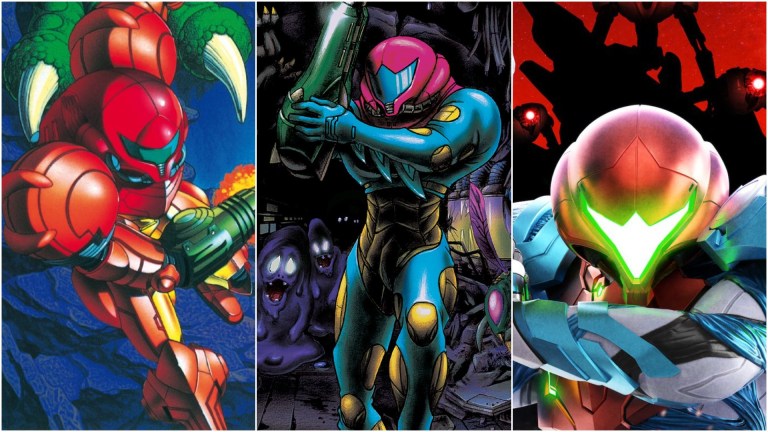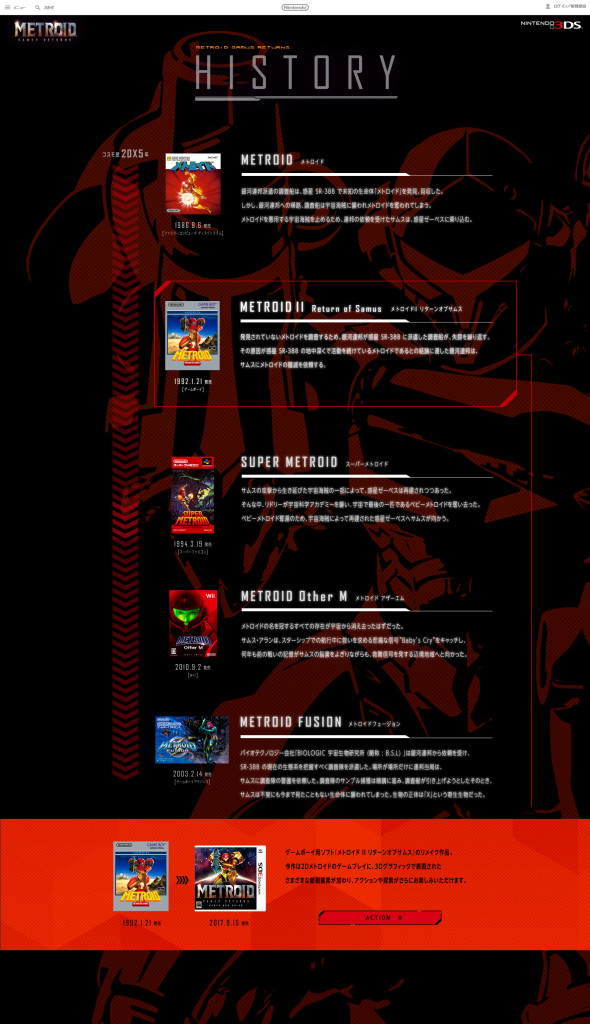The Metroid Timeline Explained: What You Need to Know Before Playing Metroid Dread
The Metroid timeline is one of Nintendo's best (and most complicated) narratives. Here's what's happened in this tale of parasites and power suits so far.

In addition to being one of the most underserved first-party Nintendo franchises, Metroid is also one of the few Nintendo franchises to have a strong, consistent, and cohesive narrative canon. The adventures of intergalactic bounty hunter Samus Aran are actually connected and impact one another in ways that you just don’t see in even Nintendo’s most celebrated series.
You’d be forgiven for not knowing all of that, though. After all, by the time Metroid Dread launches for Nintendo Switch on October 8, it will have been a staggering 19 years since Samus was asked to save the galaxy in 2002’s Metroid Fusion. Don’t know where the Metroid timeline begins and ends? You’ve come to the right place.
In this article we’ll break down every mainline Metroid installment in chronological order, covering their basic plot elements and explaining in detail how each game leads into the next. So in case you haven’t had the chance to experience this entire series for yourself (or if you just need a refresher), this is the Metroid timeline so far…
Metroid/Metroid: Zero Mission
The Metroid story begins with Samus Aran touching down on the atmospheric planet Zebes in the year 205X. Sent there by the Galactic Federation after several other failed attempts, her mission is to help prevent an evil faction of “Space Pirates” from creating dangerous biological weapons by harnessing the unique energy of Metroids: an alien species with origins dating back thousands of years (more on that later).
As the enemy’s chief stronghold, Samus is forced to traverse through Zebes’ many maze-like passageways and structures as she gains new skills, power-ups, and suit upgrades along the way. Areas such as Brinstar, Norfair, and Tourian slowly open up to her until she must eventually fend off two of the most dangerous Space Pirate commanders: Kraid and Ridley. With them out of the way, Samus faces up against their leader, Mother Brain: a mysterious mixture of both a real brain and artificial intelligence.
Defeating Mother Brain in her final form sets off Planet Zebes’ explosive self-destruct sequence. Cut to Samus racing back through debris and back to the surface in an attempt to escape. She makes it back to her gunship, where, in the original 1986 version of Metroid, she flies off after seemingly foiling the Space Pirates’ plans. However, the story continues in 2004’s Zero Mission for Game Boy Advance (an expanded remake of the original game) where Samus is unceremoniously shot down before crashing onto another part of Zebes.
With her power suit now destroyed and only a simple blaster in hand, Samus must take a stealthier approach in her “Zero” suit guise while exploring the nearby Space Pirate mothership in search of a way off-world. Eventually, she stumbles onto temple ruins belonging to an ancient race of aliens called the Chozo. There, while exploring what’s left of Chozodia, Samus uncovers a more robust power suit and learns that she was actually raised here as a child. Soon after, she encounters a mech version of Ridley. A few missile shots later she leaves the Mother Ship to blow up, finally fleeing Zebes using an available escape shuttle and destroying the Space Pirates’ Metroid research in the process.
The Metroid Prime Trilogy, Metroid Prime: Hunters, and Metroid Prime: Federation Force
The events depicted in the Metroid Prime trilogy are mostly inconsequential to that of the main series and exist in a kind of parallel but different timeline from the “Metroid” storyline. Even still, here’s a brief explainer:
Taking place between the original Metroid and Metroid II: Return of Samus, all three Prime games center on the exploits of a substance called Phazon, and Samus’ interactions with it as she does battle with a mutated version of the titular menace (the Metroid Prime). She eventually finds and defeats that menace following her exploration of the planet Talon VI, but the Metroid Prime managed to survive the battle. Harnessing DNA gathered from Samus’ Suit, the Metroid Prime uses that information to transform into Dark Samus: a mirror version of the famed bounty hunter herself.
Metroid Prime 2: Echoes picks up from there as Samus searches in the Dasha region of space for a troupe of missing Galactic Federation Marines. This leads her to the planet Aether, which happens to be home to an infected dark substance called Phazon. We eventually learn that both Dark Samus and the Space Pirates are mining the planet for that resource and that the marines Samus was originally sent to save actually died long before she got there. All that’s left to do is repel the Space Pirates and stop them from using Phazon to experiment on a Metroid type native to Talon IV. She does just that by teaming up with the natives to collapse the quickly emerging ‘Dark Aether’ alternate dimension.
Fast forward to the events of Metroid Prime 3: Corruption. The Galactic Federation has started weaponizing Phazon to the point that the element’s effects are infused into Samus by way of her new PED (Phazon Enhancement Device) suit. The one drawback, though, is that Samus will continue to be corrupted the longer she wears it. In the end, Phazon’s origin is revealed to be a sentient planet known as Phaaze. Little does Samus know that this is also where her Dark counterpart and a sect of Space Pirates are holed up, intending to spread its infection to three innocent Federation worlds. Luckily, this outcome is avoided when Samus travels to Phaaze’s core and causes it to explode. Mission accomplished… at least until Metroid Prime 4 arrives.
Metroid Prime: Hunters and Metroid Prime: Federation Force also (obviously) exist within the Metroid Prime timeline with Hunters occurring between Metroid Prime and Metroid Prime 2 and Federation Force taking place after Metroid Prime 3. Ultimately, though, both tell largely standalone stories that touch upon previous games but are wrapped up pretty cleanly within those adventures.
In case, you’re wondering, though, Hunters deals with six rival bounty hunters trying to secure an “ultimate power” and ultimately doing battle with a creature known as Gorea, while Federation Force tells the story of a group of Galactic Federation-created mechs trying to eradicate the remaining Space Pirates.
Metroid II: Return of Samus/Metroid Samus Returns
Following her battle with the Space Pirates back on Zebes, Metroid II sees Samus venture to the Metroid homeworld of SR388 to fight the dangerous creatures in their home turf. Her goal this time around is to commit genocide, scrubbing the planet of all Metroids so their power can never be used to threaten the wider worlds in the galaxy. Beginning on the planet’s surface before exploring deeper underground, Samus encounters her targets at various stages of their parasitic evolution, ranging from familiar blobs to more lizard-like threats. It seems that the Federation’s fears weren’t unfounded.
Samus blasts her way through about 50 different Metroid threats, all of which eventually lead her to destroy the Queen Metroid. It’s only afterward that Samus notices a Metroid egg begin to hatch. Not knowing where else to look or go, the baby Metroid chooses Samus as its mother. She then decides to spare this innocent version of the creatures she was tasked to destroy, fleeing what remains of SR388 after a long battle with Meta-Ridley.
That’s about where the original Game Boy version of Metroid II ended, but the 2017 remake (Samus Returns) for Nintendo 3DS offers a slightly expanded ending. In a post-credits scene, a humble Hornoad is found gnawing away on Ridley’s remains before a virus known as the X Parasite swoops in and infects it (a hint at what was to come in Metroid Fusion). Reach 100% completion in Samus Returns and it’s also revealed via unlocks that SR388 was actually home to a sect of Chozo who created the Metroids before having to vacate the planet when the X Parasite threat grew too strong.
Super Metroid
The legendary Super Metroid begins with Samus bringing the last baby Metroid to the space colony of Ceres for study and testing. She attempts to leave before almost immediately being beckoned back by a distress call, where she finds all the scientists dead and the little Metroid larva stolen. Turns out that the Space Pirates hold a grudge. Samus learns that Ridley is to blame for the massacre and that he has taken the last Metroid back to its base on Zebes: the planet where Samus first learned of the Metroid race’s existence in the first game.
After following Ridley back to Zebes and touching down on familiar ground, Samus yet again battles the Space Pirates who are starting to rebuild Mother Brain. This time she’s forced to battle four mid-tier bosses instead of two, as she finds that areas such as Norfair and Tourian have been rebuilt to be more vigorous and enemy-filled than ever before. Super Metroid culminates in Samus doing battle with a giant-sized Metroid, which almost takes her out until it suddenly stops attacking. It turns out the Metroid boss is none other than the little larva that was stolen during the game’s opening.
Shortly after, Samus must go toe-to-toe with a bigger, badder incarnation of Mother Brain. A rigorous battle follows until she is eventually saved by the now not-so-baby Metroid, which sadly falls victim to the hybrid AI’s destruction. This valiant sacrifice wasn’t in vain, however, as its death grants Samus access to the Hyper Beam. This enables her to kill Mother Brain and then flee the cursed planet of Zebes for good.
Metroid Fusion
2002’s Metroid Fusion picks up right where Super Metroid left off, with Samus returning to SR388 to obtain the last traces of Metroids with an accompanying survey crew. Unfortunately, as teased at the end of Samus Returns, she’s quickly attacked by the X Parasite and rendered out for the count. After being brought back to the Galactic Federation, Samus learns that her central nervous system has been infected by the deadly virus. Cells from the baby Metroid she once attempted to rescue are used to try and stave off the damage. The process works, and imbues her with all the Metroids’ strengths, but it also makes her weak to cold and changes her DNA.
Seeking more answers, Samus tracks the X Parasite to the Biologic Space Laboratories (BSL) research station situated above SR388. Her new mission is to rescue any remaining survivors and eradicate the X Parasite for good. However, she soon runs into a new threat known as the SA-X: a version of the parasite able to imitate her human form. Samus encounters the SA-X numerous times while exploring, and the powerful foe keeps Samus on her backfoot and forces her to act defensively.
With help from her former CO-turned-AI companion, Adam, Samus learns that the BSL station is actually a front for another attempt to clone Metroids (this time by the Galactic Federation). Adam then instructs Samus to bring back the SA-X to them alive, intending to use it as a kind of living weapon that is free of human flaws. However, Samus goes directly against those orders and sets the BSL Station on a collision course to crash into planet SR388 below, hopefully killing all remnants of the Metroids and X Parasites in the process. Did it work? That’s one of the lingering questions Metroid Dread will hopefully answer…
What About Metroid: Other M?
Long-time Metroid fans may be wondering about 2010’s controversial Metroid: Other M and where it fits within the series’ timeline. Well…it’s complicated.
Technically, Metroid Other: M occurs between Super Metroid and Metroid Fusion and draws more heavily from the “Metroid” storyline than the “Prime” storyline. While that would seemingly make it part of the storyline that Dread intends to conclude, it’s worth noting that Nintendo seemed to avoid mentioning Other M as a vital part of that storyline during their marketing blitz for Dread. In fact, it only gets a passing reference in this key infographic:

Such as it is, Other M seems to exist in a weird in-between space. Nintendo hasn’t officially removed it from the canon, but they’re also clearly not drawing from it. At the very least, we can tell you that it doesn’t seem like you’ll need to play Other M to get the full Dread experience.
The Complete Metroid Timeline in Chronological Order
Finally, here’s a breakdown of the Metroid franchise timeline that combines the Prime and Metroid storylines and places them in chronological order:
- Metroid/Metroid: Zero Mission
- Metroid Prime/Metroid Prime Pinball
- Metroid Prime Hunters
- Metroid Prime 2: Echoes
- Metroid Prime 3: Corruption
- Metroid Prime: Federation Force
- Metroid II: Return of Samus/Metroid: Samus Returns
- Super Metroid
- Metroid: Other M
- Metroid Fusion
- Metroid Dread
